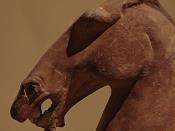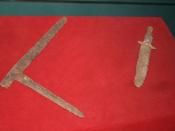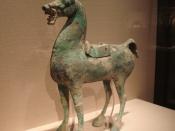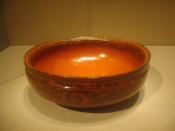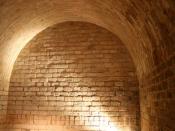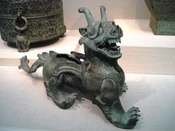November 20 2009During the Han Dynasty, China officially became a Confucian state and did really good through agriculture, handicrafts and commerce. "The population reached 50 million and the empire expanded its political and cultural influence over Vietnam, Central Asia, Mongolia, and Korea before it finally collapsed from a lethal mixture of domestic and external pressures."(Han) "The first of the two periods of the dynasty, namely the Former Han Dynasty or the Western Han Dynasty 206 BC - AD 9 seated at Chang'an and the Later Han Dynasty or the Eastern Han Dynasty 25 - 220 seated at Luoyang."(Han) The western-eastern Han convention is used nowadays to avoid confusion with the Later Han Dynasty of the Period of the Five Dynasties and the Ten Kingdoms although the former-later nomenclature was used in history texts including Sima Guang's "Zizhi Tongjian". "The dynasty was founded by the Liu family."(China)Intellectual, literacy, and artistic activities revived and flourished during the Han Dynasty.
Sima Qian, China's most famous historian came from the Han period. He produced a detailed chronicle from the time of legendary Xia emperor to that of the Emperor Wu. There were many technological advances that rose up from this period. Two of the great Chinese inventions, paper and porcelain, date from Han times.
The invention of paperIt can be said that modern empires of the Han Dynasty and the Roman Empire were the two superpowers of the known world. However, "Hou Hanshu recounted that only one Roman convoy set out by Emperor Antoninus Pius reached the Chinese capital Luoyang in 166 and was greeted by Emperor Huan."(Philosophy)Porcelain: Horse Stepping on Flying SwallowThe Han dynasty, after which the members of the ethnic majority in China, the "people of Han," are named, was notable also for its military powers. The empire expanded westward as far as the rim of the Tarim Basin, making possible relatively secure caravan traffic across Central Asia. The paths of caravan traffic are often called the "Silk Road" because the route was used to export Chinese silk. "Chinese armies also invaded parts of northern Vietnam and northern Korea toward the end of the second century BC. Han control of peripheral regions was generally insecure, however."(China) To ensure peace with non-Chinese local powers, the Han court developed a mutually beneficial "tributary system." Non-Chinese states were allowed to remain autonomous in exchange for symbolic acceptance of Han overlord ship. Tributary ties were confirmed and strengthened through intermarriages at the ruling level and periodic exchanges of gifts and goods.
The collapse of the Han dynasty was followed by nearly four centuries of rule by warlords. Although the Qin pretty much invented Chinese government, or at least the form that all subsequent dynasties would follow, in addition to standardizing Chinese culture in very vital ways (standards, weights, measures, and most importantly, writing) in Chinese history it is the Han, the longest dynasty in Chinese history, that defines Chinese culture. "The Chinese themselves frequently refer to themselves as the "people of the Han."(China)Si, MaqianFor all that, the Han were actually two dynasties, but since the second dynasty was founded by a relative of the first, they are considered a single dynasty. The dynasty itself was founded by a commoner, a fact that would later be considered important in twentieth century Chinese politics. Liu Pang was one of the rebel generals who fought the Qin; in the process of his rebellion, he gained control over the area around the Wei River, the traditional homeland of the Qin. After the fall of the Qin, China fell again into a series of territorial conflicts among various rebel generals and nobility. But in four short years, Liu Pang emerged supreme over all the territories. Taking the name, Han Kao Tsu, or "Exalted Emperor of Han," he built his capital at Chang'an and began the long process of reunifying China.
The official policy of the new Han government was to renounce Legalism and all the administrative policies of the Qin, who were hated throughout the land. The laws were made less harsh and punishments less severe. The regimentation of the population, particularly conscripted labor, was softened. They also rejected the unifying tendencies of the Qin, and divided the Chinese empire into small, somewhat independent, feudal domains under individual lords.
Work Cited"China""Han Dynasty China." < http://depts.washington.edu/chinaciv/1xarhan1.htm >
